#point cloud to cad model
Explore tagged Tumblr posts
Text

Scan to CAD Conversion Services in Gillingham
Need precise Scan to CAD conversion services in Gillingham? Our expert team transforms your 3D scans into accurate CAD models, perfect for engineering, architecture, and design projects. Enhance your workflow with detailed, efficient, and reliable conversions. Get in touch today and streamline your project!
#scan to cad services#scan to autocad services#scan to cad conversion#point cloud to cad#scan to autocad model#scan to cad modeling#3d scan to cad
0 notes
Text
Scan to CAD and point cloud to BIM modeling services
Introduction:
In the dynamic realm of architecture, engineering, and construction (AEC), leveraging cutting-edge technologies is paramount for efficiency, accuracy, and innovation. One such transformative process gaining significant traction is Scan to CAD and Point Cloud to BIM Modeling Services. These services offer a bridge between physical reality and digital design, revolutionizing traditional workflows and opening avenues for unprecedented precision and creativity. Scan to CAD and Point Cloud to BIM modeling services have emerged as transformative tools, revolutionizing how professionals conceptualize, design, and execute projects.
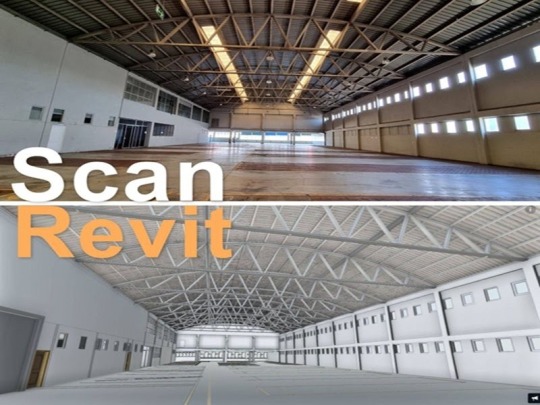
Introduction to Scan to CAD and Point Cloud to BIM Modeling Services:
Scan to CAD involves the conversion of scanned data from physical objects or environments into Computer-Aided Design (CAD) files. On the other hand, Point Cloud to Building Information Modeling (BIM) entails the transformation of three-dimensional point cloud data into intelligent BIM models. These services collectively offer a comprehensive solution for modern design challenges. Scan to CAD processes capture detailed spatial information of physical structures with remarkable precision. This data is then transformed into digital CAD models, providing designers and engineers with a comprehensive virtual representation of the scanned environment.
Enhanced Accuracy and Precision:
One of the key advantages of Scan to CAD and Point Cloud to BIM Modeling Services is their ability to capture intricate details with unparalleled accuracy. By utilizing advanced scanning technologies such as LiDAR (Light Detection and Ranging) and photogrammetry, every nuance of the physical environment can be accurately captured and translated into digital models, ensuring precise representation in the design phase.
Efficiency and Time Savings:
Traditional methods of manual measurement and drafting are not only time-consuming but also prone to errors. Scan to CAD and Point Cloud to BIM services streamline the design process by significantly reducing the time required for data acquisition and model generation. This efficiency translates into faster project delivery timelines and cost savings for stakeholders.
Seamless Integration with Existing Workflows:
These services seamlessly integrate with existing design workflows, enhancing collaboration among architects, engineers, and construction professionals. The compatibility of CAD and BIM models ensures smooth communication and data exchange throughout the project lifecycle, from conceptualization to construction and beyond.
Improved Visualization and Analysis:
By converting point cloud data into intelligent BIM models, designers gain access to powerful visualization and analysis tools. This enables them to explore different design scenarios, conduct clash detection, and simulate real-world conditions with greater accuracy, leading to informed decision-making and optimized design outcomes. Facilitating Renovation and Retrofit Projects:
Scan to CAD and Point Cloud to BIM services are particularly valuable for renovation and retrofit projects where accurate as-built documentation is essential. By capturing existing conditions in detail and creating precise digital models, designers can seamlessly integrate new elements into existing structures, minimizing disruptions and maximizing efficiency.
Supporting Sustainable Design Practices:
The ability to accurately assess existing building conditions and visualize the impact of design changes contributes to sustainable design practices. By optimizing energy efficiency, material usage, and building performance, Scan to CAD and Point Cloud to BIM Modeling Services play a crucial role in creating environmentally conscious and resource-efficient structures.
Enhancing Safety and Risk Mitigation:
Accurate documentation of existing conditions through point cloud scanning reduces safety risks associated with site visits and manual measurements. Moreover, by identifying potential clashes and design inconsistencies early in the process, these services help mitigate construction errors and costly rework, enhancing overall project safety and quality.
Adapting to Evolving Industry Trends:
As the AEC industry continues to embrace digital transformation, Scan to CAD and Point Cloud to BIM Modeling Services are poised to play an increasingly integral role. From augmented reality (AR) and virtual reality (VR) applications to the integration of artificial intelligence (AI) for automated modeling tasks, the possibilities for innovation are vast and evolving.
Conclusion:
Rvtcad represents Scan to CAD, and Point Cloud to BIM Modeling Services represents a paradigm shift in the way architectural and construction projects are conceived, designed, and executed. By harnessing the power of advanced scanning technologies and intelligent modeling algorithms, these services empower designers to push the boundaries of creativity while ensuring accuracy, efficiency, and sustainability in every project they undertake. Embracing these transformative capabilities is not just a choice but a necessity for staying competitive in today's rapidly evolving AEC landscape.
#Scan to cad#point cloud to bim modeling#scan to bim#point cloud to bim#bim services#3d laser scanning#bim laser scanning#scan to revit#as-built drawing#as-built drawings#point cloud to cad
0 notes
Text
Get the Best Laser Scan to BIM Services in Bristol, UK
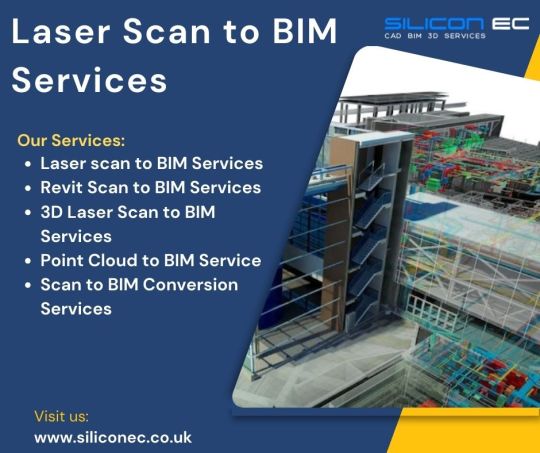
Silicon EC UK Limited offers comprehensive Laser Scan to BIM Services in Bristol, UK, catering to the evolving needs of the construction and architectural industries. Our experienced team of engineers and BIM specialists transforms raw scan data into intelligent 3D models, seamlessly integrating them into the BIM environment. Our team of experienced professionals utilizes state-of-the-art equipment to conduct comprehensive laser scans, generating highly detailed point clouds that serve as the foundation for creating accurate 3D models. Our services empower clients to streamline project planning, enhance construction coordination, and minimize errors, ultimately leading to improved project outcomes and cost savings. Our commitment to excellence, combined with a collaborative approach, ensures seamless communication and transparency at every stage of the BIM project.
Supports and software facility:
Our dedicated workforce comprises steadfast QC heads, proficient Team Leads, and experienced Engineers who possess extensive expertise. Our BIM Services adeptly utilize cutting-edge software, including AutoCAD, Tekla Structure, and Revit Structure, showcasing a commitment to staying at the forefront of technological advancements.
We are a BIM Engineering Company that presents BIM Engineering Services Bristol and other cities covering London, Liverpool, Manchester, York, Leeds-Bradford, Glasgow, Newcastle, Sheffield, and Sunderland.
Choose Silicon EC UK Limited for comprehensive Laser Scan to BIM Services in Bristol, UK, and experience the difference in precision, reliability, and innovation for your next Building project.
For More Details Visit our Website:
#Laser Scan to BIM Services#Revit Scan to BIM Services#3D Laser Scan to BIM Services#Point Cloud to BIM Service#Scan to BIM Conversion Services#Scan to BIM Services#BIM Services#Building Information Modeling Services#Building Information Modeling#BIM#BIM Services Bristol#BIM Engineering Services UK#BIM Services UK#Laser Scan to BIM Services Bristol#Scan to BIM Services UK#CAD Design#CAD Drafting#CAD Drawing#Engineering Services#Engineering Company#Engineering Firm
0 notes
Text
A Feather in Cap: UniquesCADD Receives an Award by “The Great Indian- 2023”

On October 23rd, 2023, UniquesCADD received a prestigious award for delivering high-quality and excellent BIM services in the industry. This added feather in the cap was received under the category of “BIM & CAD Service” by “The Great Indian Entrepreneurship, Business & Startup Awards & Conference 2023”. This milestone was only possible because of the talented team who worked dedicatedly on each project to deliver exceptional services. A big congratulations and thank you to each team member.
#bim services#bim modeling services#scan to bim services#mep bim services#outsourcing bim services#architectural bim services#structural bim services#cad to bim services#point cloud to bim#bim drafting services#revit 3d modeling
0 notes
Text
I can't tell you which laptop to buy
Over the years, I have been asked "Which laptop should I buy?" many, many times. We have now arrived at a point where I can no longer meaningfully answer this question.
In the past, I would have said something like "Get a laptop with enough RAM, and make sure the keyboard, trackpad, and display all work for you. You can't swap out the keyboard, mouse and display like you can in a desktop."
In the past, I would have said something like "Are you just using it for e-mail, Facebook, and Netflix? Are you doing a lot of office productivity stuff? Will you be giving slide presentations? Do you also want to do some light gaming? Do you need an SD card slot for your digital camera? Are you doing video editing/CAD modelling/cinematic 3D rendering?"
It really depends on what kind of laptop you want. You could want a desktop replacement, because you don't have the space for PC. You could want a "luggable" machine that you take from your office to the meeting room or the lecture hall, and back and occasionally to a different location in the trunk of your car. You could want a portable laptop that you keep in a laptop bag, backpack, or briefcase, and sometimes use on your lap or in a café if you are one of these people. You could want a "light" laptop that you carry with you at all times.
I still couldn't tell you which laptop to buy. So many people these days use their phone or a tablet for e-mail, facebook, and netflix that it doesn't really make sense to recommend a small and light laptop. You'd want to be a step above that. So many people use the "cloud" for all their documents and data, so it doesn't make sense for them to think about having a large HDD. If you own a gaming a console and a desktop PC, and you write your e-mails on a tablet, it doesn't really make sense to have a cheap laptop, but it also doesn't make sense to have a big laptop, unless you change your workflow.
Some people still need a CD drive, a large hard disk, or VGA-out, but usually there's a USB-C dock for that use case.
If you never use your laptop anyway, you may as well give Ubuntu a chance. It even runs Steam!
72 notes
·
View notes
Note
Are there any primitives or operations you wished parametric CAD software had?
This is tricky, because parametric CAD is what I learned to design on so its feature set feels "natural".
I don't really think so! Most of the obvious innovations are already covered, SolidWorks can take a model back and forth between parametric and primitives modelling in its own weird way, Inventor has really great design for manufacture features, from what I've seen SolidEdge has done some clever stuff with the solver to help you design parts that are customizable as you go down the chain. Who knows what's going on in NX these days, not me. There's definitely some holes in the sense of individual packages lacking features, but almost anything you can ask has been implemented somewhere, by someone.
Good quality design for manufacture tools really do help, I remember doing sheet metal stuff in Inventor back before they cut off free Inventor access and being able to see your generated sheet and bend allowances so clearly was great, and now even OnShape has pretty solid design helpers.
A thing small shops and hobbyists would probably like is better handling of point clouds and photogrammetry for matching parts, since you're much more likely to be working with parts and projects where you didn't do all the design, I've spent many hours trying to accurately model a mating feature, but even that's like. Pretty good these days, importing 3D scans into an editor is pretty standard and the good CAD packages will even let you pick up holes and clean up point clouds directly from the scan.
I'm not that much of a mech eng, and never really was, my CAD is mostly self taught for simple tasks, real mechanical designers no doubt have better opinions on this, @literallymechanical probably has thoughts on T-splines.
37 notes
·
View notes
Text
Last year, I had the idea to make a Santa Sleigh I could fly beneath my drone. This ended up not happening as my computer was away for repairs. This year, I don't have that problem.

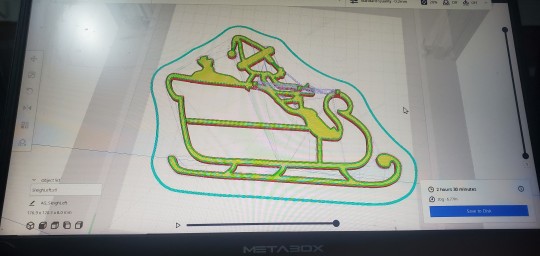
Here's the cad model, drawn up based on some clip art I found.
Everything needs to be outlines to minimise air resistance, and keep it as light as possible.
As you can see, this Santa is being made with an Australian twist.
Here's the Santa in print:

And the first "Boomer" (Kangaroo)

Several hours of printing later, and it was time to stick it together. Wanting strength, I used skewers, even though they were a little thicker than I originally planed for.

I'm balancing the roos on the back, to make sure

It must be wide enough to not confuse the drone's downward sensor.
The morning of Christmas Eve, I awoke to this weather forecast.

I proceeded with final assembly anyway. There were gaps in the clouds, it was only bucketing down some of the time.
The strings need to be equidistant from the balance point, and all the same length.
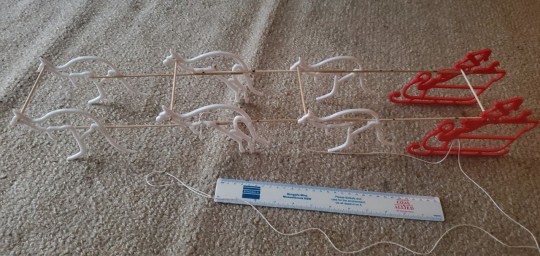
Launch has to be done very carefully. Going to have to fly very smoothly to prevent twisting.
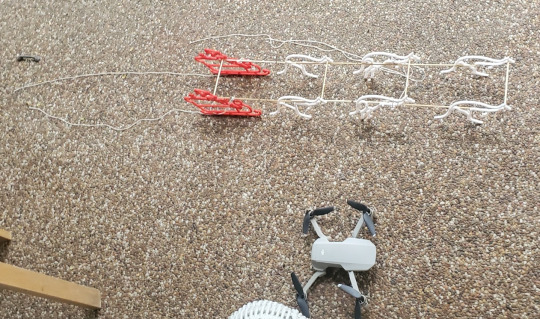
It flies!

I took it down to the park.


Here is the view from the air:
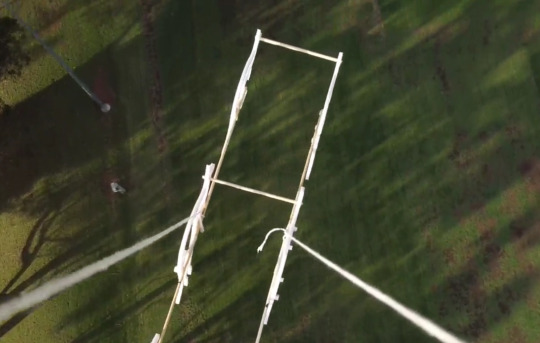

Maybe if the weather holds, there'll be people in the park to see it.
Merry Christmas!
#Christmas#Aussie Christmas#Drones#drone#3d printing#3d printing adventures#mavic mini#santa sleigh#It is about at the limit of what the drone can carry. Even with this weight if i go to long the Drone will start to complain.#it handles tolerably but doesn't sit exactly right. It veers a little and the sleigh easily turns too much. Needs a steady hand#but the drone did cope with a little wind and the small amount of shaking. though the sleigh is about 2/5 of the drone's mass#Idk if anyone younger knows the song about the 6 white boomers. It feel out of favour when the songwriter fell into disgrace
50 notes
·
View notes
Text
What is BIM Architectural outsourcing & Drafting Services?
BIM Architectural Services refer to the practice of subcontracting architectural design and drafting tasks to external firms or professionals specializing in Building Information Modeling (BIM). In this arrangement, architectural firms or companies outsource certain aspects of their projects, such as creating detailed drawings, 3D modeling, or BIM coordination, to specialized service providers.
Outsourcing BIM architectural drafting services offers several benefits to architectural firms:
Cost Efficiency: Outsourcing allows firms to access skilled professionals at a lower cost compared to hiring in-house staff. This can result in significant cost savings, especially for projects with fluctuating workloads or specialized requirements.
Expertise and Specialization: BIM outsourcing firms often have a team of experienced professionals with expertise in architectural drafting and BIM technologies. By leveraging their specialized skills, architectural firms can ensure high-quality deliverables and efficient project execution.
Focus on Core Competencies: Outsourcing non-core tasks such as drafting allows architectural firms to focus on their core competencies, such as design creativity, client relationships, and project management. This can lead to improved productivity and better utilization of resources.
Scalability and Flexibility: Outsourcing provides architectural firms with the flexibility to scale their workforce up or down based on project requirements. This agility enables firms to handle peak workloads, meet tight deadlines, and adapt to changing market demands more effectively.
Access to Advanced Technologies: BIM outsourcing firms often invest in the latest BIM software and technologies to deliver innovative solutions to their clients. By partnering with these firms, architectural companies can leverage cutting-edge tools and workflows without investing in expensive software licenses or training.
Overall, BIM architectural outsourcing and drafting services enable architectural firms to enhance their competitiveness, improve project efficiency, and deliver high-quality designs to their clients. By partnering with experienced outsourcing providers, architectural firms can streamline their workflows, reduce overhead costs, and focus on delivering exceptional architectural solutions.
United-BIM Inc. is a certified SBE/MBE BIM Modeling Services Company based in East Hartford, Connecticut. Our services include BIM Architectural Services, Architectural Drafting Services, 3D Rendering Services Structural Modeling and Detailing (Rebar, Precast, others), MEP-FP Modeling and Detailing, BIM Coordination & Clash Detection Services, Revit Family Creation Services, Underground Utility Locating Services, On-site & off-site Coordination Services, Onsite & virtual meetings participation, Point Cloud Scan to BIM, CAD to BIM Services, BIM for Facility Management, Accurate Shop Drawings Creation, As-built Drawings Services, Electrical Design Services & more.
1 note
·
View note
Text
Architectural Laser Scanning for Building Renovation
3D Scanning Technology Revolutionizing Renovation Projects
In recent years, 3D laser scanning has become a game-changer for building renovation. By capturing highly accurate digital records of existing structures, this advanced technology streamlines the renovation process from planning through construction.
Architectural laser scanning not only accelerates project timelines—reducing them by up to 80%—but also plays a crucial role in preserving historical architectural details. Its precision and efficiency are redefining how architects, engineers, and contractors approach renovation projects.
Understanding Laser Scanning Technology
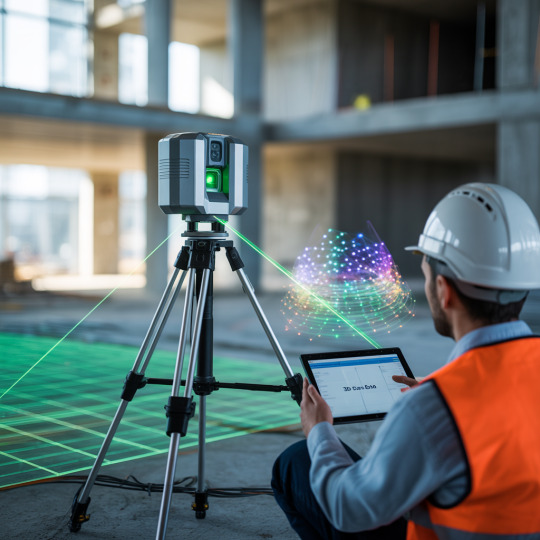

Laser scanning technology operates by emitting laser beams that reflect off surfaces and return to the scanner, capturing millions of data points known as "point clouds."
These dense point clouds represent the geometry of the scanned environment in 3D with a typical accuracy range of 2-3mm.
Key capabilities include:
Capturing comprehensive spatial relationships, material conditions, and architectural features.
Recording manufacturer-specific details such as door and window dimensions, HVAC equipment, and more.
Seamless integration with BIM (Building Information Modeling) and CAD platforms, enhancing digital workflows.
Delivering rich geographic and architectural data used for precise modeling and analysis.
Key Benefits for Renovation Projects
Laser scanning offers several distinct advantages over traditional surveying methods, especially for renovation and retrofit projects:
Enhanced Safety: Reduces the need for physical access to hazardous or hard-to-reach areas.
Speed: Approximately 40% faster than traditional hand-measuring or manual survey methods.
Accuracy: Delivers near-exact documentation of existing conditions, essential for accurate design and construction.
Historical Preservation: Ideal for capturing intricate details in heritage buildings, ensuring their preservation during renovations.
Reduced Errors: Minimizes on-site measurement mistakes, reducing costly rework.
Enhanced Project Planning
High-resolution point cloud data enables architects and engineers to begin the renovation process with a complete understanding of the existing structure. Benefits include:
Detailed site analysis with reliable structural data.
Insight into existing limitations, constraints, and irregularities.
Early detection of structural issues, such as sagging beams or misaligned foundations.
Creation of accurate as-built documentation for use across design disciplines.
Helps reduce rework and avoid costly surprises during construction.
Streamlining Design & Construction
One of the major strengths of architectural laser scanning is its ability to streamline design and construction coordination:
Seamless integration with BIM and CAD software platforms like Revit, AutoCAD, and Navisworks.
Provides a shared, accurate data environment for all stakeholders to collaborate.
Reduces change orders by up to 35% by ensuring that the design is aligned with real-world site conditions.
Facilitates complex structural modifications with confidence and precision.
Speeds up decision-making by providing detailed visual references and data-backed models.
Quality Assurance & Compliance
Laser scanning plays a pivotal role in quality control and ensuring compliance during renovation:
Verifies that construction aligns with architectural and structural specifications.
Helps teams ensure compliance with building codes and regulations.
Accurately documents as-built conditions for comparison against original designs.
Detects deviations or discrepancies between planned and actual structures.
Supports structural analysis and validation, ensuring safety and long-term performance.
Case Study: Historical Building Preservation
A notable application of laser scanning is in the renovation of historical buildings:
Enables precise documentation of delicate or intricate architectural features like moldings, columns, and cornices.
Supports accurate alignment of new structural elements with the original architecture.
Offers digital preservation of heritage details, ensuring they are retained for future generations.
Allows for virtual design testing using 3D models before making any physical changes.
Minimizes on-site disruption, making the scanning process less invasive than traditional surveys.
Implementation Process
The implementation of a laser scanning workflow typically includes the following steps:
Initial Site Assessment: Determines scanning scope and project requirements.
Scanner Placement Strategy: Ensures full coverage of the building, interior and exterior.
Data Collection & Point Cloud Generation: Field scanning produces millions of precise data points.
Data Processing & Integration: Point clouds are cleaned, registered, and integrated into BIM or CAD systems.
Ongoing Reference: The scan data remains available throughout the renovation to resolve design or construction queries.
ROI & Cost Benefits
Architectural laser scanning offers an impressive return on investment for renovation projects:
Reduces overall project timelines by up to 30%, allowing quicker project delivery.
Helps avoid expensive design changes mid-project by catching issues early.
Cuts labor costs for initial surveying by approximately 50%.
Prevents costly rework by providing exact existing conditions before construction starts.
Creates lasting digital documentation, useful for ongoing maintenance and facility management.
Conclusion: Transforming Renovation Projects
Architectural laser scanning is transforming the renovation landscape by introducing a new level of accuracy, efficiency, and insight. By providing:
Unprecedented documentation precision
Improved decision-making based on real-world data
Clear, consistent information for all stakeholders
Significant reductions in time and cost
Preservation of both structural integrity and aesthetic value
…it is rapidly becoming an essential tool in modern building renovation. Whether working on a historical structure or a commercial upgrade, 3D laser scanning ensures the highest level of planning, execution, and project success.
#building design#architecture#architectural laser scanning#historical structure#3d laser scanning#as built documentation#bim#building information modeling
0 notes
Text
What is the Turnaround Time for Dallas 3D Laser Scanning?
Reality IMT Inc As industries across Dallas continue to embrace advanced technology for design, construction, and facility management, 3D laser scanning has become an essential tool for gathering accurate, real-time spatial data. Whether you're working on a commercial building renovation, manufacturing facility upgrade, or infrastructure documentation, one critical factor to consider is turnaround time—how long it takes from scanning a site to receiving usable deliverables.
In this article, we’ll explore the typical turnaround time for 3D laser scanning services in Dallas, the key factors that influence delivery timelines, and how you can speed up the process for your project.
Understanding 3D Laser Scanning and Its Workflow
3D laser scanning is the process of using specialized equipment—such as terrestrial laser scanners—to capture detailed measurements of a physical space or object. The scan generates a point cloud, which can be processed into as-built models, CAD files, BIM models, 2D floor plans, or other visual and data-rich outputs.
The process typically involves:
Initial consultation and site evaluation
On-site scanning
Post-processing and data registration
Deliverable creation (e.g., CAD drawings or 3D models)
Review and revisions (if required)
Each phase has its own time requirements depending on project size and complexity.
Typical Turnaround Time in Dallas
The average turnaround time for 3D laser scanning projects in Dallas ranges from 2 days to 3 weeks, depending on several factors. Here’s a general breakdown based on project size and scope:Project TypeEstimated Turnaround TimeSmall residential scan (under 3,000 sq. ft.)2–5 business daysMedium commercial building (10,000–30,000 sq. ft.)1–2 weeksLarge industrial or multi-level facility2–3 weeksComplex infrastructure projects3+ weeks
These timelines typically include scanning, post-processing, and delivery of requested outputs. However, more complex models or expedited schedules may affect these estimates.
Key Factors That Influence Turnaround Time
While the size of the project is a major factor, several other considerations can influence how quickly you’ll receive your deliverables from a 3D laser scanning provider in Dallas.
1. Project Scope and Size
Larger spaces require more scanning setups and data capture, increasing both scanning time and post-processing efforts. A single-family home may take just a few hours to scan, while a 100,000-square-foot warehouse could take several days.
2. Type of Deliverables Needed
Do you need only a raw point cloud? Or do you require BIM models, 2D drawings, topographic maps, or Revit-compatible files?
Raw point clouds can be delivered quickly—often within 1–3 days.
Fully processed BIM models may take 1–2 weeks or more depending on the level of detail required.
3. Level of Detail (LOD)
The Level of Detail (LOD) refers to how refined and comprehensive the final models are. LOD 100–200 is relatively quick to produce, while LOD 300–500 (common for construction or fabrication) requires more modeling time.
4. Post-Processing Time
Post-processing involves registering point clouds, cleaning noise, aligning scans, and preparing them for further use. This is typically one of the most time-consuming parts of the project, especially when high precision is needed.
5. Scheduling and Availability
Turnaround time also depends on the provider’s schedule. If you're working with a busy Dallas-based 3D scanning firm, you may need to wait a few days just to get on-site. Always book in advance if you're working with tight construction timelines.
6. Revisions and Client Feedback
If multiple review cycles or revisions are involved, the overall timeline may extend. Clear communication of project needs up front can help minimize these delays.
Expedited 3D Laser Scanning in Dallas: Is It Possible?
Yes, many 3D scanning providers in Dallas offer expedited services for urgent projects. In such cases, you might receive raw point clouds in 24–48 hours, and detailed deliverables within 3–5 business days, depending on complexity.
However, expedited service usually comes with additional costs, which can range from 20% to 50% above standard pricing. It’s ideal for:
Emergency facility repairs
Time-sensitive construction schedules
Last-minute documentation for permitting
Be sure to ask your provider about their fast-track options and how they manage quick turnarounds without sacrificing quality.
Typical Workflow Timeline (Step-by-Step)
Here’s a look at a sample workflow and the typical time each step takes for a standard commercial project in Dallas:StepTimeframeInitial consultation & quote1–2 business daysOn-site scanning (10,000 sq. ft.)1 dayData processing & registration2–5 business daysDeliverable creation (2D plans or 3D model)5–10 business daysReview & adjustments1–3 business daysTotal Estimated Time7–15 business days
This can vary significantly based on deliverable type, data complexity, and whether revisions are needed.
Tips to Speed Up Turnaround Time
If you’re under tight deadlines, here are a few tips to help you receive your scan results as quickly as possible:
✔ Be Clear on Project Goals
Outline exactly what you need—such as floor plans, BIM models, or mesh models—so the provider can allocate the right resources.
✔ Prepare the Site
Ensure the site is clean, accessible, and safe for the scanning team. Removing unnecessary obstructions helps the scanner collect clean data faster.
✔ Choose a Local Provider
Working with a Dallas-based scanning service helps reduce travel delays and ensures faster on-site response.
✔ Ask About File Format Compatibility
Let your provider know your preferred file types (e.g., .rcs, .e57, .dwg, .rvt). Mismatched formats can delay project handoff.
✔ Schedule Ahead
If your project is part of a larger workflow, book scanning services early so they align with your timeline.
Dallas Industries That Rely on Fast 3D Scanning
Several industries in Dallas benefit from quick-turnaround scanning solutions:
Construction & Contracting: Fast as-built scans for renovation and retrofits
Architecture & Design: Quick access to site dimensions for planning
Manufacturing: Plant layout documentation for equipment installation
Real Estate & Facilities Management: Floor plans and 3D tours for marketing and space utilization
Civil Engineering & Infrastructure: Survey-grade data for public works and infrastructure upgrades
Speed and precision are especially crucial in urban environments like Dallas, where construction and development projects often face tight deadlines and regulatory timelines.
Conclusion
The turnaround time for 3D laser scanning in Dallas depends on multiple factors, including the size of the project, the level of detail required, and the type of deliverables. While small projects may be completed in 2–5 days, larger and more complex assignments can take up to 3 weeks or more.
Understanding the process and planning ahead will help ensure your project stays on schedule. Whether you're scanning a single room or an entire facility, partnering with an experienced Dallas-based 3D laser scanning provider is the key to getting accurate results—on time.
Need fast and accurate 3D laser scanning in Dallas? Reach out to local professionals who can deliver the data you need—when you need it most.
Let me know if you'd like to localize this article further with specific Dallas-based companies or keywords!
Contact us: Reality IMT Inc Serving Dallas TX 469-277-7550 https://realityimt.com/3d-scanning-services-dallas-texas/

#3D Laser Scanning Service Dallas#3D Laser Scanning Dallas#3D Building Scanning Services#3d building scanning#3D Laser Scanning Services#3d laser scanning construction#3D Measurements Services
0 notes
Text
Top 6 Proven Best Practices to Optimize Your Scan to BIM Workflow

With the integration of 3D laser scanning services within BIM workflows in the AEC industry, the way experts approach design, remodeling, and facility management projects has been completely transformed. Scan to BIM, which transforms laser-scanned data into detailed Building Information Models, makes accurate depictions of existing structures possible.
Workflow optimization is crucial for efficient Scan to BIM Services to guarantee high-quality deliverables.
Get the most out of your 3D Scan to BIM projects with these tried-and-true best practices.
Defining Clear Project Scope and Purpose
Establishing the goals and scope of a project is one of the most critical phases in the 3D Scan to BIM process. This step is essential, as the defined objectives will determine which areas require the most focus and the level of detail necessary for data collection.
For instance, if one is remodeling a historic structure, it might require exact scans of complex architectural elements. On the other hand, a simple structural update may call for less thorough scans, prioritizing significant structural components.
By adopting a selective and strategic approach to scanning, it is possible to reduce project costs significantly and conserve considerable time in data processing.
Defining Scope for Efficient Workflows
The Point Cloud to BIM services involve a streamlined process with clarity of project scope, eliminating the need to collect excessive data and targeting only pertinent point cloud data from the beginning.
To collect accurate data, team members can use specific scanning methods, viewpoints, and resolutions, which help reduce processing time and data storage requirements.
Success Story: 97,000 Sq.Ft. of Scan to BIM Conversion in Just 27 Days
Invest in Quality-oriented 3D Laser Scanning Services
A successful Scan to BIM workflow is built on top-notch 3D laser scanning services. Reliable BIM models depend on accurate, comprehensive, clean point cloud data, documented by skilled scanning professionals. The project's success is also impacted by the caliber of laser scanning equipment and offered precision and accuracy.
Selecting the Right Equipment and Service Provider
Mobile and drone-based scanners are well-suited for large-scale or difficult-to-reach locations while terrestrial laser scanners are extremely accurate for stationary scans of complicated situations.
If 2D drawings are required in addition to BIM models, working with scanning providers who specialize in Scan to CAD Services can improve data output.
Significance of Pre-Scan Planning
By conducting a thorough pre-scan planning session, the Scan to BIM services provider can have a deeper understanding of the project's complexity.
Teams can discuss specific areas that require the greatest level of accuracy and identify potential issues to create a scanning strategy.
Streamline Point Cloud Data Processing
The next crucial stage in the Point Cloud to BIM workflow is processing the Point Cloud data after completing site scans.
Proper cleaning, filtering, and segmenting of large raw point cloud data is essential. A cloud of millions of points is transformed into manageable, structured data in this step, which facilitates its interpretation and manipulation in BIM software.
Cleaning and Organizing the Point Cloud Data
Noise and extraneous data can diminish the effectiveness of 3D BIM modeling.
Filtering and noise-reduction features in point cloud processing software automatically clean up the data by organizing the data, such as labeling and segmenting various building aspects.
Leveraging Automated Tools
By decreasing the time spent on manual editing, automated software like Autodesk ReCap and Cloud Compare, can improve workflow efficiency and enable BIM specialists to concentrate on more intricate areas of model creation.
To help teams distinguish components within the point cloud and obtain more detail when transferring data from 3D Laser Scanning Services to BIM, several of these tools include color-coding and data segmentation.
Read More: How Al Enhances the Accuracy of Scan to BIM Models?
Effective Collaboration among Stakeholders
Architects, engineers, contractors, and facility managers are among the many stakeholders who collaborate on Scan to BIM projects. Effective teamwork is crucial to keep everyone on the same page regarding project objectives and prevent expensive delays.
Real-time data sharing and editing are now made possible by cloud-based platforms and BIM-specific collaboration tools, which are imperative to project success.
Real-Time Collaboration and Issue Resolution
Using cloud-based solutions profoundly benefits the AEC teams by enabling simultaneous access to updated project information.
Architectural teams can discuss changes with engineering teams, inspect 3D models, and annotate them in real-time, minimizing the probability of errors that could later cause the project failure.
Utilizing Common Data Environments
Common data environments (CDEs) offer a single location to store and retrieve project files, model updates, and notes.
With features like version control, automated update alerts, and authorization settings, tools like Autodesk BIM 360 or Trimble Connect make collaboration easy.
CDEs minimize inconsistencies and expedite decision-making in Scan to BIM Services by guaranteeing that each team member utilizes the most recent model version.
Regular Review Meetings and Checkpoints
Regular project meetings with all stakeholders are equally important along with technological measures.
These gatherings offer chances to discuss potential difficulties, address problems, and assess project progress.
A productive work environment and high-quality results for Point Cloud to BIM conversions are fostered by ensuring alignment among scanning experts, BIM modelers, and project managers.
Read More: Scan to BIM vs Traditional Methods : Which is Best for Your Project?
Invest in Scalable Technology
It is crucial to use scalable technology and software to manage big datasets, particularly for intricate or lengthy projects.
Even on larger projects, teams may prevent bottlenecks and guarantee seamless processing by investing in strong workstations, lots of data storage, and cloud computing solutions.
Incorporate Visual References
Context, material details, and texture information can be added to the BIM model by integrating high-resolution photos with point cloud data. Photographic data and 3D laser scanning services combine to create a more visually complete model that is very helpful for documentation and facilities management.
AI-powered Scan to BIM Services for Efficient Workflows
The AEC firms can convert architectural Scan to BIM models in just 1 day using AI-powered services by ScantoBIM.online. The AI tool provides unparalleled accuracy and quality while minimizing human intervention.
The companies can choose from 100+ architects and engineers with specialized skills and expertise, ensuring precise execution of projects.
Key Features
Advance AI tools and plugins for affordable solutions
Advanced AI tools can convert 10,000 sq ft of Scan to BIM with 1 day turnaround time
Quality control tool to check 100+ parameters in models, ensuring consistency
Conclusion
In addition to increasing model generation speed and accuracy, a well-optimized scan to BIM workflow guarantees BIM models with detailed information and insights for continued facility management. Project teams can produce dependable BIM models that last over time by establishing project goals, investing in premium 3D laser scanning services, efficiently organizing point cloud data, and encouraging stakeholder cooperation.
By following these best practices, the AEC firms can make better decisions, reduce expensive rework, and ensure that the 3D Scan to BIM services result in high-value outcomes for every project.
#Scan to BIM Services#3D Scan to BIM services#3D laser scanning services#Point Cloud to BIM Sevices#Point Cloud to revit sevices
0 notes
Text
Point Clouds in Revit for Comprehensive BIM Modeling
Introduction:
In the realm of Building Information Modeling (BIM), the integration of point clouds into Revit has emerged as a game-changer. Point clouds, generated through laser scanning technology, offer a wealth of spatial data that can revolutionize the accuracy and detail of BIM models. In this article, we delve into the transformative potential of point clouds within the Revit environment, exploring how they enhance the comprehensiveness of BIM modeling.

Understanding Point Clouds:
Point clouds represent a collection of data points in three-dimensional space, capturing the precise geometry and spatial characteristics of physical environments. These data sets are generated through laser scanning devices, which emit laser beams to measure distances and record millions of points within a scene. The result is a highly detailed representation of real-world structures, encompassing everything from intricate architectural features to subtle surface irregularities.
Point clouds serve as digital replicas of physical spaces, offering an immersive and detailed view of real-world environments. Generated by advanced laser scanning devices, these data sets consist of millions of individual points, each representing a specific location in three-dimensional space. Laser scanners emit laser beams that bounce off surfaces within a scene, measuring distances and capturing the spatial coordinates of points in the process.
Integration with Revit:
Revit, renowned for its prowess in BIM modeling, provides a robust platform for integrating point clouds seamlessly into the design process. By importing point cloud data directly into Revit, architects, engineers, and construction professionals gain access to a wealth of information that serves as a foundation for their BIM models.
This integration bridges the gap between the physical and digital realms, allowing for unparalleled accuracy and fidelity in virtual representations of built environments. The integration of point clouds with Revit, a premier software in Building Information Modeling (BIM), marks a significant advancement in the construction industry's digital transformation. Revit's capabilities extend far beyond traditional CAD software, offering a comprehensive platform that facilitates the creation, analysis, and documentation of building designs. With the ability to directly import point cloud data, Revit empowers architects, engineers, and construction professionals to leverage the wealth of information captured through 3D laser scanning technologies.
Enhancing Accuracy and Precision:
One of the primary advantages of incorporating point clouds into Revit is the enhancement of modeling accuracy and precision. Traditional methods of manual measurement and documentation often fall short in capturing the intricacies of complex structures. Point clouds, on the other hand, offer a level of detail that surpasses conventional techniques, enabling designers to create BIM models that closely mirror reality. From as-built documentation to renovation projects, the use of point clouds ensures that BIM models accurately reflect existing conditions, minimizing errors and discrepancies throughout the design and construction process.
Facilitating As-Built Documentation:
In retrofit and renovation projects, accurate as-built documentation is essential for informed decision-making and seamless execution. Point clouds provide a comprehensive record of existing structures, allowing designers to capture precise measurements and dimensions with minimal disruption to ongoing operations. By importing point cloud data into Revit, stakeholders can create as-built BIM models that serve as a reliable reference throughout the project lifecycle. This streamlined approach not only accelerates the documentation process but also mitigates the risks associated with inaccuracies and discrepancies in existing conditions.
Visualizing Complex Environments:
The visualization capabilities of point clouds within Revit are unparalleled, offering designers the ability to immerse themselves in highly detailed 3D representations of physical spaces. Whether analyzing existing structures or conceptualizing new designs, the integration of point clouds provides invaluable insights into spatial relationships, material properties, and architectural nuances. By overlaying point cloud data onto BIM models, designers can make informed decisions regarding spatial layout, clash detection, and design optimization, thereby improving the overall quality and efficiency of the design process.
Streamlining Collaborative Workflows:
Effective collaboration lies at the heart of successful BIM projects, and point clouds play a pivotal role in facilitating communication and coordination among project stakeholders. By centralizing point cloud data within the Revit environment, multidisciplinary teams can work collaboratively on a unified platform, ensuring that everyone has access to the most up-to-date information. This integrated approach fosters greater transparency, reduces rework, and enhances the overall efficiency of project delivery.
Conclusion:
In conclusion, Rvtcad the integration of point clouds into Revit represents a significant advancement in the field of BIM modeling. By harnessing the power of laser scanning technology, designers can create comprehensive and highly accurate virtual representations of built environments. From enhancing accuracy and precision to facilitating collaborative workflows, point clouds offer a multitude of benefits that elevate the quality and efficiency of BIM projects. As technology continues to evolve, the synergy between point clouds and Revit is poised to reshape the future of architectural design and construction.
#point clouds#bim modeling#scan to bim#point cloud to bim#bim services#3d laser scanning#as-built drawing#bim laser scanning#scan to revit#scan to cad#as-built drawings#point cloud to cad
0 notes
Text
Get the Best Building Information Modeling Services in London, United Kingdom

Silicon EC UK Limited is an Engineering Company that provides Building Information Modeling Services in London, United Kingdom. Our BIM Services play a crucial role in improving project outcomes by enhancing collaboration, reducing errors, optimizing designs, and improving overall project efficiency. Our BIM Design Services utilize specialized software and technology to create a comprehensive 3D model that encompasses various aspects of a construction project, including design, planning, construction, and operation. We offer BIM Clash Detection Services that involve meticulous scrutiny of 3D models, pinpointing spatial inconsistencies or clashes that might hinder construction, and enabling proactive solutions in the design phase. Ultimately, BIM Services optimize construction workflows by ensuring smoother project execution, cost savings, and timely delivery of high-quality structures.
Contact us today to discuss your Building Information Modeling Services needs and discover how we can help you turn your architectural dreams into reality.
For More Information Visit to Our Website:
#Building Information Modeling Services#BIM Services#BIM Clash Detection Services#BIM Engineering Services#AsBuilt BIM Services#BIM Family Creation Services#Laser Scan to BIM Services#BIM Coordination Services#CAD to BIM Services#Revit BIM Modeling Services#BIM Services London#BIM Engineering Company#BIM Engineering Firm London#BIM Engineering Company London#BIM#Point Cloud to BIM Services#BIM 3DModeling Services#Building Information Modeling#Revit BIM Services#BIM Design Services#BIM Consulting Services#CAD Design#CAD Drafting#CAD Drawing#Engineering Company#Engineering Firm#Engineering Services
0 notes
Text
UniquesCADD - Leading Outsourcing BIM Services Provider
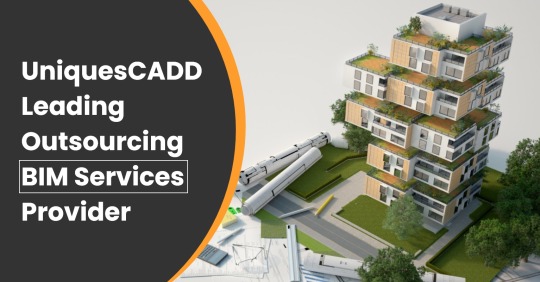
With constant evolution in the AEC industry, UniquesCADD has become a leading outsourcing BIM services provider. Since its foundation, UniqueCADD has earned the name of a renowned BIM service provider also proficient in offering various architectural services with international clientele based in the UK, USA, Germany, and the Netherlands.
Over the years and with a skilled team of professionals, UniquesCADD has been diligent in delivering each project with accuracy and client satisfaction which made them into the top news platforms - OpenPR
#architectural bim services#bim modeling services#bim services#cad drafting services#cad to bim services#pdf to bim services#point cloud to bim services#scan to bim services#bim outsourcing services#bim services india
1 note
·
View note
Text
Driving Construction Excellence with BIM and CAD Solutions by Advantage Engineering Technologies, PLLC
In the ever-evolving construction and engineering landscape, precision, efficiency, and collaboration are no longer just advantages — they are necessities. Whether it's a commercial build-out or an industrial infrastructure project, seamless coordination between design, detailing, and execution is essential. This is where Advantage Engineering Technologies, PLLC stands out. As an industry leader in BIM coordination services, BIM design services, CAD drawing services, and sheet metal fabrication drawings, they empower construction firms and contractors with robust and intelligent solutions that improve project outcomes and reduce costly delays.
The Power of BIM Coordination Services
Building Information Modeling (BIM) has revolutionized how architecture, engineering, and construction (AEC) professionals approach building projects. BIM coordination services are the foundation of effective project collaboration and delivery, especially in complex projects where multiple systems converge.
Advantage Engineering Technologies offers comprehensive BIM coordination that ensures architectural, structural, and MEP (mechanical, electrical, and plumbing) systems are seamlessly integrated and free from clashes. Their team of experienced BIM coordinators uses platforms like Autodesk Revit and Navisworks to:
Identify and resolve design conflicts before construction
Facilitate coordination meetings and model review sessions
Streamline communication among stakeholders
Reduce RFIs and construction change orders
Through 3D clash detection and intelligent model management, they help contractors and engineers avoid construction errors and improve field productivity. The result is better build quality, reduced costs, and on-time project delivery.
BIM Design Services for Intelligent Project Execution
BIM design services go beyond 3D modeling—they provide data-rich, intelligent models that support the entire building lifecycle, from design and documentation to construction and facility management.
Advantage Engineering Technologies offers BIM design services tailored to your specific needs, including:
Architectural and structural modeling
MEP system layout and modeling
Point cloud to BIM conversions
As-built BIM models
Their BIM designs are highly detailed, helping clients visualize the end result and make informed decisions early in the project. With a focus on accuracy and constructability, every model is developed with a deep understanding of how systems interact in the real world.
This holistic approach not only enhances visualization and planning but also enables smoother coordination among trades, easier fabrication, and improved long-term maintenance strategies.
CAD Drawing Services for Precise Documentation
While BIM has become the industry standard for many large-scale projects, CAD drawing services remain a cornerstone of engineering and construction documentation, especially for fabrication, shop drawings, and detailed layouts.
Advantage Engineering Technologies provides CAD services that include:
2D drafting and detailing
Mechanical and electrical layouts
HVAC and plumbing drawings
Shop and installation drawings
Their CAD experts work with AutoCAD and other industry-standard tools to ensure clear, precise, and code-compliant documentation. These CAD drawings are essential for:
Communicating exact dimensions and materials
Facilitating accurate fabrication and assembly
Meeting building codes and permitting requirements
Supporting field crews with clear instructions
By combining traditional CAD techniques with modern BIM workflows, Advantage Engineering Technologies delivers flexible and reliable documentation solutions for projects of any scale.
Sheet Metal Fabrication Drawings That Ensure Accuracy
For HVAC contractors and fabrication shops, sheet metal fabrication drawings are critical for producing ductwork and metal components that fit perfectly on-site. Even a small error can lead to time-consuming rework or installation delays.
Advantage Engineering Technologies specializes in creating shop-ready, detailed fabrication drawings for sheet metal contractors. Their services include:
Duct layout and sizing based on mechanical design
Annotation of materials, gauges, and joints
Spool drawings for efficient fabrication
Coordination with structural and architectural elements
These detailed drawings are fully coordinated with other MEP systems to ensure field accuracy. With a sharp eye for detail and a deep understanding of fabrication standards, the team provides drawings that eliminate guesswork and reduce scrap, saving both time and money on the job site.
0 notes
Text

Need accurate BIM models from point cloud data in New York? Trust Silicon Engineering Consultants to turn real-world scans into structured, insightful models for smarter project decisions.
Visit Us:
#ScantoBIMServices#BIMClashDetectionServices#PointCloudToBIMModeling#3DLaserScanningtoBIM#PointCloudModelingServices#BIMModelingfromPointCloud#AsBuiltBIMfromPointCloud#PointCloudtoRevitBIM
1 note
·
View note